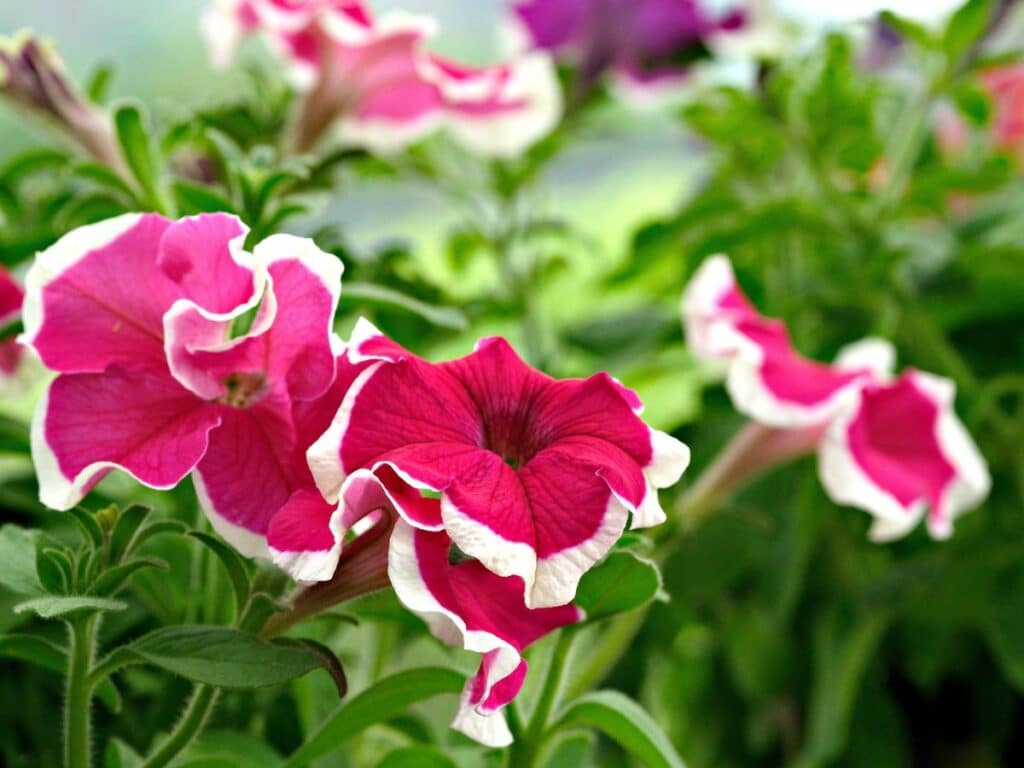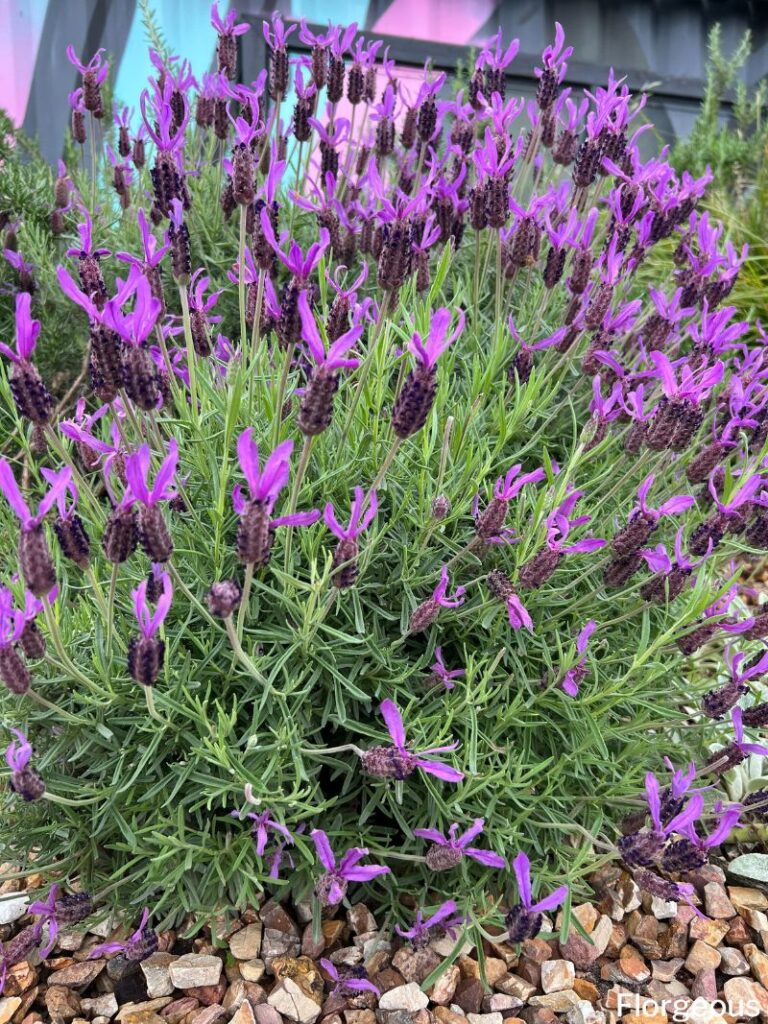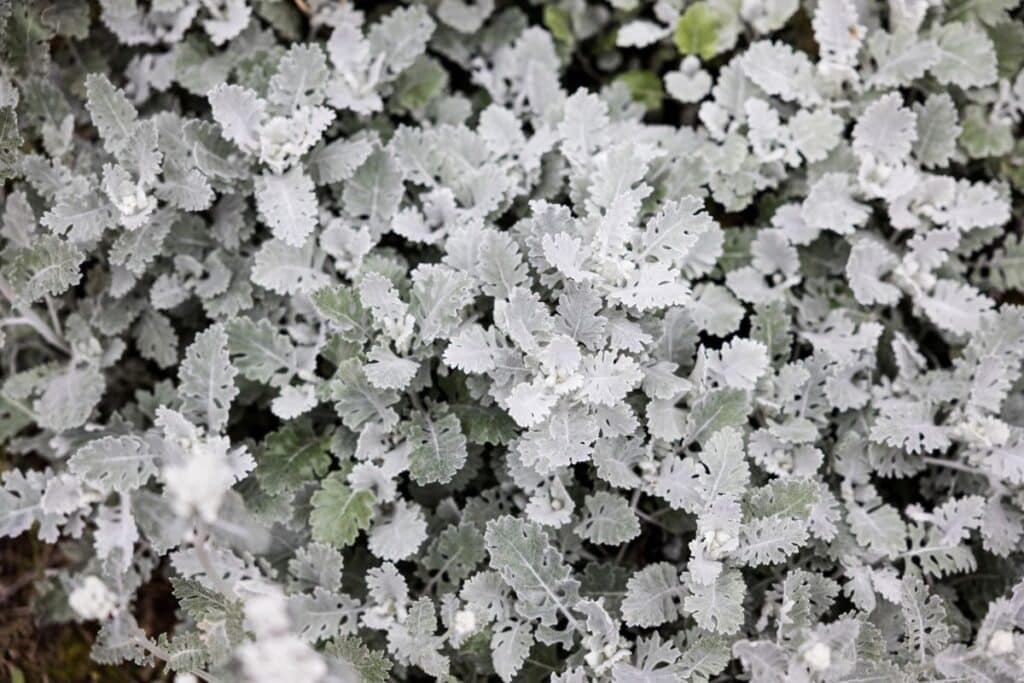Find out what to grow with dusty miller in this guide where we discuss all the best species to combine for a gorgeous garden bed.
Dusty Miller (Jacobaea maritime), also known as silver ragwort or silver dust, is one of the most prized foliage plant varieties in ornamental gardens because the silvery color of the leaves with their soft and fluffy appearance instantly creates lots of contrast and texture in garden beds. Dusty Miller yellow flowers are small and daisy-like, but they are relatively insignificant compared to the plant’s striking foliage.
This plant has many applications. It is useful as a ground cover, border plant, filler plant, or backdrop for other low-growing perennial plant species. The foliage also has medicinal properties although most grow it for its charming looks.
This herbaceous plant is ideal for making the other plants in your garden pop and you can pair this foliage with all sorts of companion plants like the ones we are going to discuss in this article.
What to Plant With Dusty Miller
The dusty miller plant is mostly included in flowering garden types because the silvery foliage enhances the color of flowers. It is also an ideal plant to add if you want to create more contrast between your lawn and flowers.
To get the most striking effect, you should choose your surrounding plants very carefully. Some plant varieties might be too tall, similar in color, or overpowering to work alongside dusty millers while others might simply not grow well in the same conditions.
This silvery plant loves direct sunlight but it will tolerate partial shade as long as it is established in well-drained soil.
If planted in light shade, the plant will, however, lose its silvery color. It is best to establish this foliage where it will receive at least 8 hours of direct sunlight and to choose companion plants that can also handle this type of warm environment. Dusty miller mature plants can grow up to 3 feet tall and branch out as far as 9-12 inches.
Let’s take a quick look at some of the best dusty miller companion plants to include if you want to create an eye-catching garden bed.
Petunias

- Botanical Name – Petunia spp.
- Height – 6 – 18 inches (15 – 45 centimeters)
- Colors – Any flower color with vibrant green foliage
- Bloom Season – Spring
- Pairing Benefits – Ground cover, aesthetic appeal, attract pollinators, filler plant, border plant
Petunias (Petunia spp.) are a good option for companion planting with silver ragwort because they have a similar growing height and create beautiful blooms that will be highlighted alongside the dusty millers.
You can find petunias in just about any color and there are even varieties with different flower shapes like wave petunias or flat petunias. There are even some fragrant varieties that can help you create a more aromatic garden.
Petunias grow in USDA growing zones 10 – 11 and they need full sun or they won’t grow well or flower. They are also quite drought-tolerant and can suffer from root rot if they receive too much water.
Dusty miller and petunias can be mixed in your flower beds and you can add as many different colors as you like to create a striking effect.
Creeping Phlox
- Botanical Name – Phlox stolonifera
- Height – 8 inches (20 centimeters)
- Colors – Pink, purple, blue, and white flowers with dark green foliage
- Bloom Season – Mid-summer or late fall
- Pairing Benefits – Ground cover, aesthetic appeal, attract pollinators, weed control, border plant
Creeping phlox (Phlox stolonifera) is a good option if you are looking for something to grow in front of dusty miller plants because it is lower in stature with a maximum height of just 8 inches. This ground cover is ideal for cool-toned gardens and the purple flowers will accent the dusty miller growths even more.
When you plant dusty miller, you should try to keep phlox in the front because these lower plants need full sun and well-draining soil. Over time, this flowering plant will quickly start to creep all over the garden because it can reseed itself.
Ornamental Grasses
- Height – 3 inches up to 15 feet tall (10 to 457 centimeters)
- Colors – Variety of foliage and flowering blooms
- Bloom Season – Spring or early summer for cool varieties
- Pairing Benefits – Garden filler, aesthetic appeal, weed control, backdrop
There are a vast variety of ornamental grasses that can form an attractive background behind dusty millers. Some grass varieties are just as drought tolerant and hardy as your millers and you can pick and choose from various foliage colors there are even some varieties that produce flowers.
Ornamental grasses are ideal for adding more texture to your garden beds and are a perfect addition to rock gardens. To grow these companion plants with dusty miller, you should consider the variety. It is best to keep taller grass varieties in the back and to establish short clumpy varieties in the front.
Lavender

- Botanical Name – Lavandula
- Height – 20 – 24 inches (50 – 60 centimeters)
- Colors – Purple, lavender, or blue flowers with silver-grey foliage
- Bloom Season – Summer
- Pairing Benefits – Aesthetic appeal, repel pests, border plants, reduce garden maintenance, conserve water
Lavender (Lavandula) is an excellent selection for any dry and sunny spot in your garden and can be a perfect companion for dusty millers. Both of these plants are often seen in rocky gardens or xeriscaping concepts because they are so hardy and both can handle a full day of full sun.
Many gardeners also love to pair these two species because the dusty green foliage of lavender blends well with the silver foliage of the dusty millers.
When you are pairing the two in the same garden bed, you should be careful to establish lavender in the back. Dusty millers will stay a little bit shorter and are perfect for concealing the bare base of the lavender bushes.
Related: What not to plant with lavender
What NOT to Plant with Dusty Miller
Dusty miller’s unique ability to tolerate full sun throughout the day makes it incompatible with shade-loving plants.
You should also avoid growing it with plants that require lots of water because too much moisture can cause root rot in your dusty miller plants.
Here is a quick look at plants to avoid when you are growing dusty miller.
Shade plants
It is best to avoid all shade lovers in a dusty miller bed. A good example is begonias. Begonias attract pollinators but they will quickly wilt and die in dry and sunny conditions.
Hostas, coral bells, ferns, and dead nettle are all plant varieties that you should avoid with dusty miller because neither will benefit from this type of combination.
Japanese Forest Grass
Some ornamental grass varieties like Japanese forest grass (Hakonechloa) also won’t tolerate excessive sun. This grass variety can grow in well-drained soils but they need to be kept moist at all times.
Tall and Bushy Plants
You can add tall plants like shrubs, bushes, or trees to your garden bed but these should be kept well behind your dusty millers. Tall and bushy plants and trees will overshadow the dusty millers which can affect the color of the foliage and can impact healthy growth.
If you want to add shrubs then you should focus on something like Boxwoods that can be trimmed short and kept in line.
FAQs
How far apart do you plant dusty miller?
Dusty Miller (Senecio cineraria) plants are typically spaced about 12 to 18 inches apart when planting. This spacing allows the plants to have enough room for proper air circulation and prevents overcrowding as they mature.
Where do dusty miller grow best?
Dusty Miller plants thrive best in well-draining soil and prefer full sun to partial shade. They are well-suited for growing in garden beds, borders, or containers. In terms of climate, they are often grown as annuals in cooler climates and as perennials in warmer climates.
Final Thoughts
Dusty miller can be grown with a large variety of companion plants like petunias, creeping phlox, ornamental grasses, lavender, and quite a few other plants such as pansies and violas.
We hope that this companion plants for dusty miller guide made it a little bit easier to select some good neighbors for your dusty miller plants. And if you want to learn more about companion planting for other plant varieties then you should have a look at some of the other guides we have. With our site, you can find all the best companion plant options for all the most popular plant species.
Up next:
References
Reference List:
https://plants.ces.ncsu.edu/plants/centaurea-cineraria/
https://extension.umn.edu/flowers/growing-petunias
http://www.pnwplants.wsu.edu/PlantDisplay.aspx?PlantID=621
https://hort.extension.wisc.edu/articles/japanese-forest-grass-hakonechloa-macra/
https://hgic.clemson.edu/factsheet/ornamental-grasses-and-grass-like-plants/
https://www.canr.msu.edu/resources/identification-guide-to-boxwood-and-its-lookalikes
Close
*image by Wirestock/depositphotos







